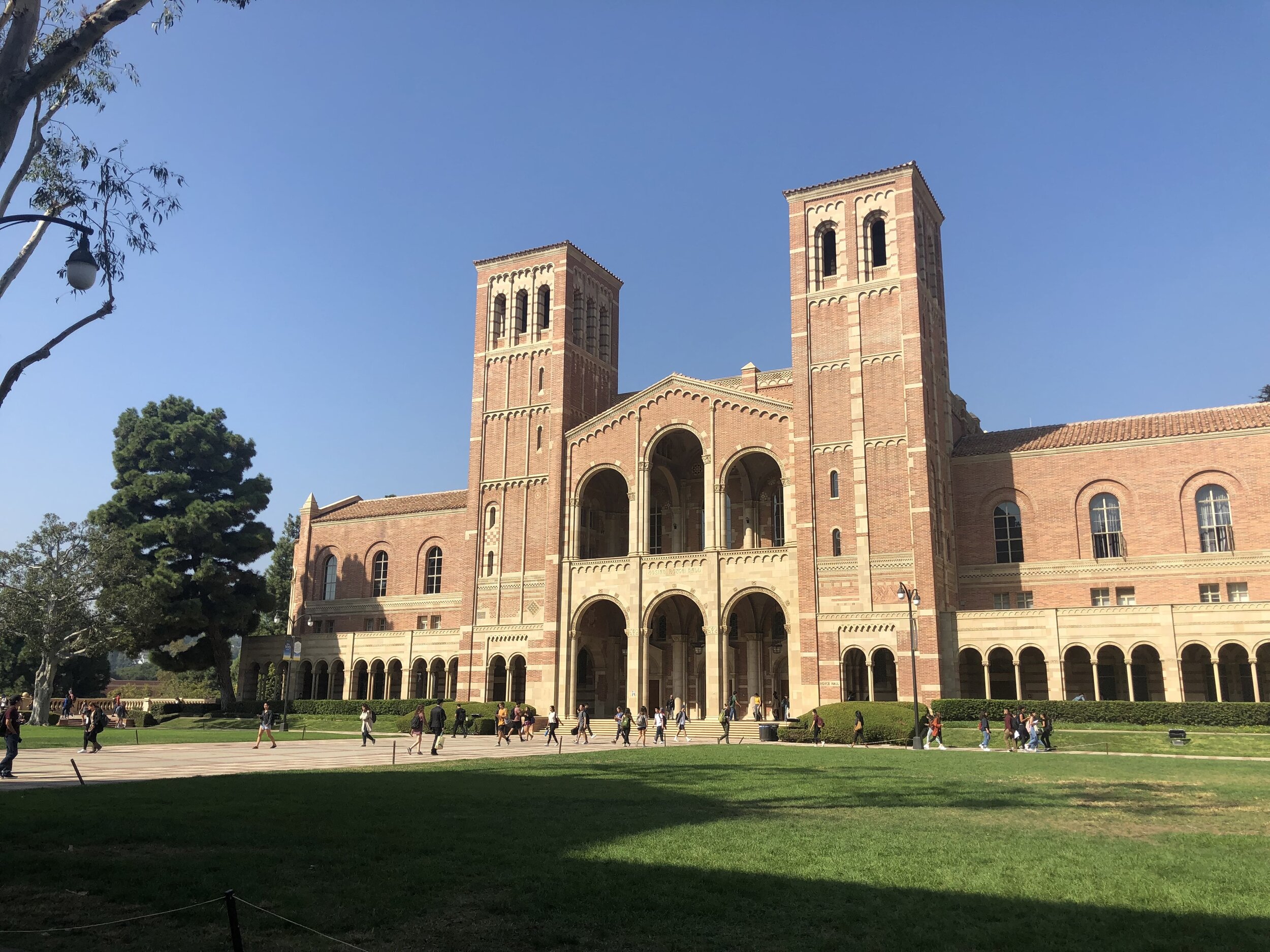USC vs. UCLA: Which College Is Better?
/Learn key differences between the two most famous universities in Southern California when it comes to academics, student life, and admissions
the usc vs. ucla debate transcends the famous football rivalry
----
Part 1: Introduction
As you gear up for application season, you and your child may be curious about the higher education offerings in sunny Los Angeles, California. If it looks like your child will be a strong applicant for some of the nation’s top schools, you’re probably curious about LA’s two top universities — the University of California, Los Angeles (UCLA) and the University of Southern California (USC), famous cross-town rivals.
According to U.S. News and World Report, UCLA and USC rank 15th and 28th in their list of best national universities, respectively. So you may be asking yourself: How different are UCLA and USC, really? Is one more prestigious than the other? Could my child be a competitive applicant for both schools? And if your child’s been admitted to both (congratulations!) how can you choose?
If you’re looking for clarity on the differences between UCLA and USC, you’re not alone! We’re here to help you navigate the ins and outs of these two famous SoCal schools and help you and your child decide which (if not both) might make their college list.
----
Part 2: UCLA: One of the nation’s elite public universities
USC vs. ucla: UCLA was ranked #20 on the u.s. news and world report best colleges list for 2023
First, let’s consider each school in its own right, starting with the University of California, Los Angeles.
UCLA, widely considered a Public Ivy, is one of nine schools in the University of California, the Golden State’s public college system. Its 419-acre campus is located in the Westwood neighborhood of Los Angeles, at the foot of the Santa Monica mountains and a few miles from the Pacific Ocean. (We said miles, not minutes—Los Angeles is notoriously car-centric and plagued by bad traffic.)
UCLA prides itself on being a large and diverse academic community. It has the largest undergraduate enrollment in the whole UC system with over 30,000 undergrads—as well as over 14,000 graduate and medical students. Students come from all 50 states and over 100 foreign countries, though the majority of undergrads are Californians. In addition, the student body is quite diverse—35 percent of undergrads are Asian, 26 percent are white, 21 percent are Hispanic, 6 percent are African American, and 9 percent are international students.
UCLA offers 141 majors and more than 90 different minors, many of which rank in the best academic programs in the nation, and instruction in 40 different languages. Attending a massive public university in one of America’s largest cities means tons of diverse opportunities. With over 1,300 clubs and student organizations, UCLA encourages everyone to broaden their horizons and find their niche among a cross-section of cultures. Students are expected to complete a capstone project related to their major to deeply explore and define their passions.
UCLA is especially strong in STEM and engineering fields. It has world-renowned laboratory facilities and is home to one of the world’s best medical programs at the David Geffen School of Medicine. Plus, UCLA is routinely in the top 10 in the nation for the number of medical school applicants they supply each year.
The downsides of UCLA are typical of any large public university—class sizes are large, administrative tasks can be difficult for students to navigate, and undergraduates have to be ready to take responsibility for their education more than they would at a smaller school with greater individual student resources.
If your child prefers the opportunities of a large research-oriented university over the personalized amenities of a smaller school, UCLA might fit the bill.
(Further reading: How to Get Into UCLA)
----
Part 3: USC: A top-ranked research powerhouse
USC vs. UCLA: USC was ranked #25 on the u.s. news and world report best colleges list for 2023
The University of Southern California is a private research university located near the heart of downtown Los Angeles.
Unlike the sprawling Beverly Hills-adjacent UCLA, USC’s urban University Park campus is located in Downtown LA’s Arts and Education Corridor. Its Health Sciences campus, including the Keck School of Medicine, sits just northeast of Downtown Los Angeles (DTLA).
USC prides itself on having the resources of a large research institution with the student-centered culture of a liberal arts school. Despite a relatively large undergraduate enrollment of 21,000 students, it boasts an average class size of 26 students and a 9:1 student to faculty ratio.
USC offers over 150 different majors and concentrations, with countless scholarly research opportunities offered to undergrads. In keeping with its liberal arts-ish culture, USC emphasizes interdisciplinary thinking and encourages students to double major in seemingly unrelated subjects (Business Management and Cinema Studies is one popular combination). It’s also famous for its connection to the entertainment industry and Hollywood.
Every student must take a freshman seminar, a literary course, and two global perspective courses that teach students about global social responsibility. Students can also participate in USC Global, which offers one of the best study abroad selections of any U.S. university with over 50 programs on 5 different continents.
USC has made a lot of progress on its financial aid program, but it still has the reputation of a private school attended by mostly children from affluent families and remains a very expensive option with a total price tag of around $360,000 over four years. Adding to that expense, many students and former students say it’s necessary to have a car.
If your child is interested in a large research university but still wants the student-centered support system and interdisciplinary thinking of a much smaller school, USC may be the one for them.
(Further reading: How to Get Into USC)
----
Part 4: USC vs. UCLA: School experience
The primary difference between UCLA and USC is that the first is a public institution while the second is private. That means that UCLA is primarily funded through state government allocations and USC money is from student tuition and private donors. This may not sound like much, but it makes a difference in comparing tuition and financial aid packages. Tuition at UCLA is significantly less expensive than tuition at USC, especially if your child is a California resident.
When taking into account the total cost of attendance (i.e. tuition, room, board, and fees), the yearly sticker price at USC is around $52,000 higher than it is for California residents attending UCLA. Even for out-of-state students, UCLA is nearly $20,000 cheaper than USC.
However, both schools have need-blind admissions practices, which means they do not consider your family’s financial status when evaluating the merit of your child’s application. And if your child is accepted, both schools commit to meeting 100 percent of your demonstrated financial need.
There are some discrepancies in student culture. For instance, UCLA’s student body is more diverse than USC, though USC has more international students. And then there’s the culture of California itself. Less than half of USC’s undergraduates hail from the Golden State, whereas more than 75 percent of UCLA undergrads are California residents.
USC also has a much more prominent culture of Greek life than UCLA—more than a quarter of both men and women at USC participate in sororities and fraternities.
Both schools have strong NCAA sports programs, as well as a historic football rivalry. But USC has a stronger sports-oriented school culture and a rabidly supportive alumni fan base.
Since we’re talking about Los Angeles, the cost of living is expensive at both institutions. The area around UCLA is much more expensive than the area around USC, but the school also guarantees three years of housing for students. (At USC, most leave student housing after freshman year.)
----
Part 5: USC vs. UCLA: Admissions
UCLA and USC use two different application systems. Since UCLA is part of the UC system, it uses the UC Application. USC, on the other hand, uses the Common App.
If your child decides to apply to UCLA, they should take advantage of the UC application (not to mention the application fee!) and apply to other schools in the UC system. The UC Application is different than the Common App, and includes a series of special short-format essays known as “personal insight questions” rather than the traditional personal statement essay.
There are a couple other crucial components to UC applications. First, admissions teams will only consider in-state applications from students who have a 3.0 GPA, and out-of-state applications from students with a 3.4 GPA. USC doesn’t have a cutoff. However, that’s not to say it isn’t extremely competitive. Matriculants from their freshman class of 2026 had an average GPA in the range of 3.82-4.0
Second, UC schools no longer consider the SAT or ACT in their admissions processes. On the other hand, while USC is currently test-optional due to the coronavirus pandemic, students with impressive scores can still include them in their application.
In terms of selectivity, the schools rank fairly equally—UCLA has an 8.8 percent acceptance rate (getting more competitive every year) and USC’s acceptance rate is 10 percent. But remember: 75 percent of UCLA students are in-state applicants, so if your child is applying as an out of state applicant, admission will be especially challenging.
Overall, it may be harder to get admitted to UCLA if your child is not a California resident than USC. If they have the good fortune of being a Californian, it might be a bit easier to be admitted to UCLA than USC.
Final thoughts
Both UCLA and USC are great choices for high-achieving students interested in attending a large research-oriented university (including those looking for a great premed school in California).
As you navigate the college process or help your child make their final decision on where to matriculate, take some time to figure out what’s most important—school culture, class size, or particular courses of study? If your child knows they want to study business management or enter the film industry, or if they prefer smaller classes, USC would be a better option. But if they don’t mind big lecture halls, are set on a STEM field, and skip out on football games for academics, UCLA could be a more ideal fit.
In any case, we recommend a college visit to both schools if possible. It’s always good to give your child a chance to soak up the in-person atmosphere—plus, a weekend in the California sunshine never hurts.







